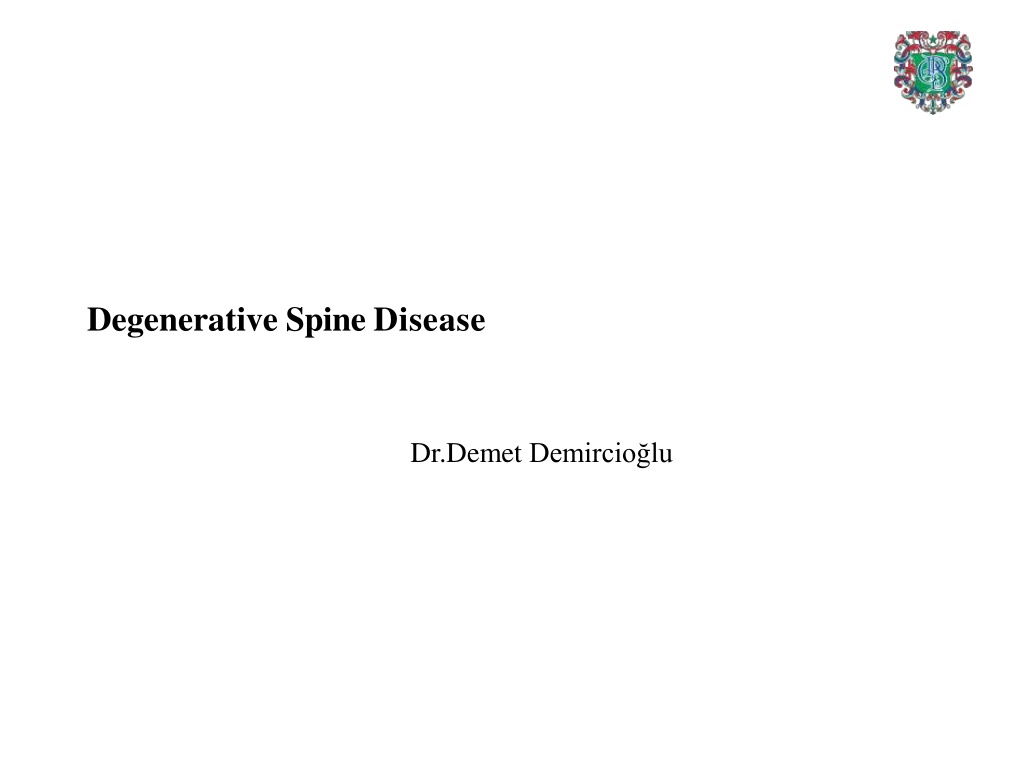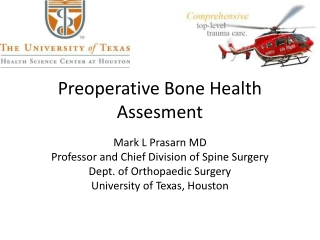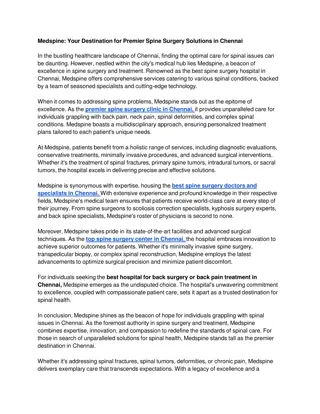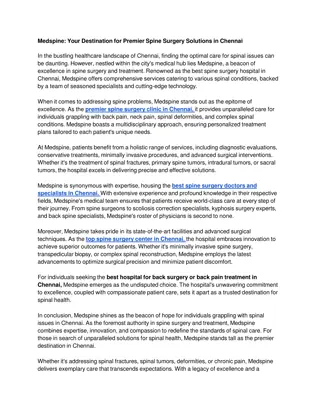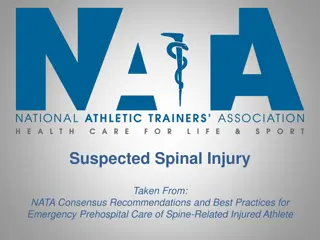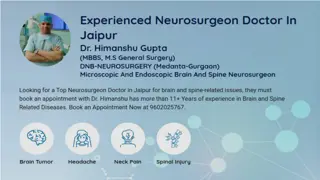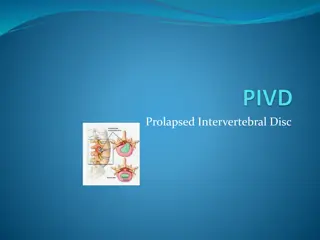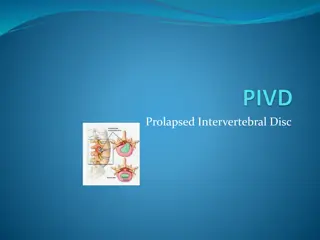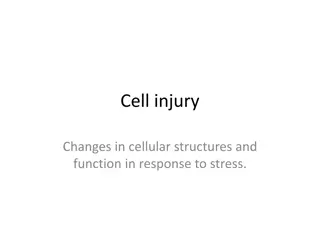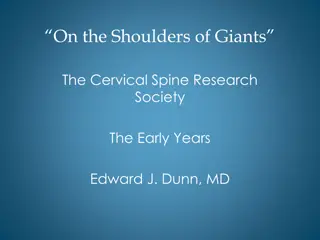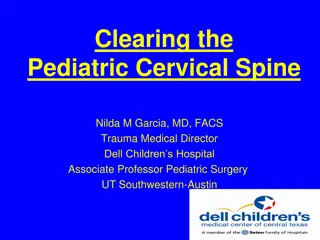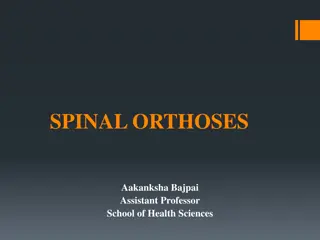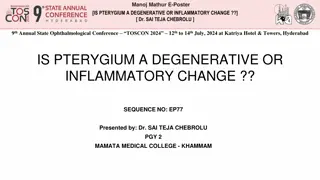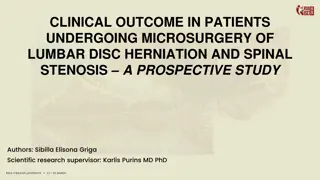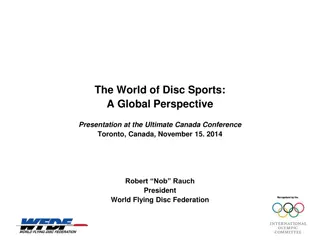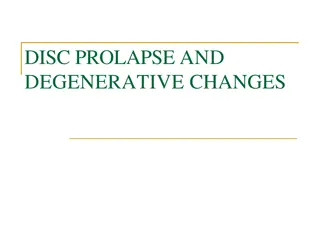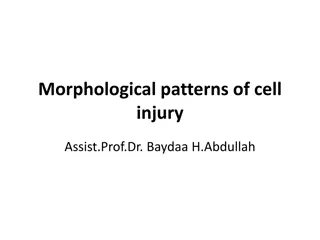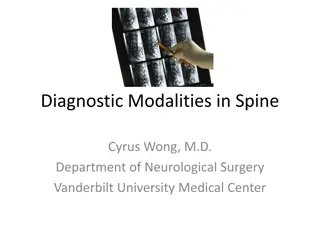Degenerative Spine Disease and Disc Degeneration
Degenerative spine disease is a prevalent condition affecting millions, leading to substantial healthcare costs. The anatomy and physiology of spine degeneration involve the three-joint complex theory. Pathologically, disc degeneration impacts the nucleus pulposus and annulus fibrosis, contributing to disc herniation. Mechanistically, aging and repetitive loading play key roles in disc degeneration. The process involves the development of circumferential tears, herniation, and dorsal joint degeneration, ultimately causing spinal degenerative disease.
Download Presentation

Please find below an Image/Link to download the presentation.
The content on the website is provided AS IS for your information and personal use only. It may not be sold, licensed, or shared on other websites without obtaining consent from the author.If you encounter any issues during the download, it is possible that the publisher has removed the file from their server.
You are allowed to download the files provided on this website for personal or commercial use, subject to the condition that they are used lawfully. All files are the property of their respective owners.
The content on the website is provided AS IS for your information and personal use only. It may not be sold, licensed, or shared on other websites without obtaining consent from the author.
E N D
Presentation Transcript
Degenerative Spine Disease Dr.Demet Demircio lu
Problem Statement 2002survey 26% americans low back pain and 14% - neck pain 890 million office visits due to back pain 2005- JAMA - $86 billion health expenditures in spine relatedproblems
Anatomy and Physiology of SpineDegeneration Kirkaldy-Willis three-joint complex Theory spine at each level composed of three joints complex that are affected in degenerative process This comprise of intervertebral disc and two zygapophysealjoints (dorsal articulating joints) Degeneration of any one joint leads to degeneration of the other two, initiating a casacade that leads to spinal degenerative disease
Pathology.. Disc Degeneration.. Components of disc nucleus pulposus semigelatinous structure situated near the center remnant of notochord; composed of mucopolysaccharide + salt + water annulus fibrosis multilayered circular structures that surrounds the pulposus composed of fibrocartilaginous lamellae; stiffer thannucleus cartilagenous end plates
Mechanism of discdegeneration Part of natural aging process Repetitive loading results in forces that foster degeneration Aging fibrous tissue dessication collagen and proteoglycans are replaced with
Continued Axial pressure less compliant annulus develops circumferential tears most frequently in dorsolateral aspect tears enlarge and develop into radial tears herniation of nucleus pulposus Relative dorsal location of nucleus pulposus and presence of posterior longitudinal ligament lead to classical dorsolateral disc herniation Circumferential bulge of annulus due to annular tear and osteophyte formation at the attachment of the annulus to vertebral body narrowing of central canal and neural foramen loss of disc height
Dorsal joint degeneration Articulating facets from superior and inferior vertebral segments Joints composed of cartilage, synovial membrane andcapsule Aging formation synovial reaction, fibrillation of articular cartilage, osteophyte laxity of jointcapsule Leads to subluxation of joint Osteophyte spinal canal and lateral recess stenosis
Combine Three-joint complex Degeneration Individual aging process of disc and dorsal facet joints are interlaced to contribute to the clinical manifestation of spondylosis Disc degeneration loss of discheight subluxation of dorsaljoints This compounds to natural process of facet jointdegeneration Subluxation of rostral vertebral body ventrally with respect to the caudal vertebral body (spondylolisthesis) This results in further narrowing of neural foramina entrapment lateral nerve root
Three stages of Degenerative SpineDisease Dysfunction stage Destabilization stage Restabilization stage
Dysfunction stage.. Characterized by synovial reaction in dorsal joint and small tears in the intervertebral discs Minor or absent clinical symptoms that are best treated conservatively
Destabilization Stage.. Kirkaldy-Willis defines this stageas greater degeneration in the three-joint complex, manifesting as laxity and subluxation in the dorsal joints and progressive disc degeneration Abnormal spinal motion Natural mobility of the spine lost Compounded by advanced disc degeneration and disc height reduction lead to spondylolisthesis Rx core strengthening and flexibility program to stabilize and normalize dysfunctional motion segment
Restabilization Stage Instability is reduced via osteophyte formation secondary to a prior increased joint laxity and loss of disc interspaceheight Resolution of symptoms can occur due to gradually decreasedspinal motion There may be radiculopathy from spinal nerve entrapment or claudication symptoms from central canal and lateral recess stenosis
CT Myelography effective alternative to MRI for assessing neural elements, central or foraminal stenosis MRI gold standard for evaluation spinal canal stenosis soft tissue surrounding spinal canal, discs, ligamentum flavum and facet joints visualized hypertrophy of PLL, ligamentum flavum and facet hypertrophy can be localized specifically
Discography more invasive diagnostic strategy can be done if clinical presentation does not match the findings in other imaging modality useful to identify and characterize disease involves injecting contrast material into the disc in question normal cervical disc tolerates 0.2-0.5 ml fluid whereas a degenerated disc can accept 0.5-1.5 ml fluid if the pain produced following contrast injection is concordant with the typical pain experienced by the patient pathological
TreatmentOptions Non operativemanagement natural course of spinal stenosis 47% patients with neurogenic claudication and radiculopathy symptomatic improvement without intervention Reason progressive disc dehydration root compression shrinking of disk decrease in
Medical symptomatic relief to reduction in inflammation NSAIDs Narcotics to supplement progresses and improvesspontaneously muscle relaxants shows some benefit Systemic oral steroids anti inflammatory effects may reduce nerve root irritation masks degenerative process until it Physical reconditioning via physical therapist strengthen core muscles Flexibility exercise to help preserve normal motion
Epidural steroid injections short term benefit Facet joint injection (long acting anesthetic and steroids) 33% patients reported >50% pain relief result consistent with placebo also; hence controversial key to efficacy is proper selection of patients with facetsyndrome Facet syndrome defined as pain in the hips and buttocks area, cramping thigh pain, and back stiffness that is worse in the morning, without lower extremity paresthesia
Spinal Manipulative Therapy (SMT) by chiropractors, physical therapists and osteopathic physicians 3 main types of manipulations therapeutic massage, mobilization and manipulative procedures Hypothesis neck or back pain is caused by either a limited range of motion or abnormal dorsal intervertebral joint motion SMT resets the joint by extending the joint beyond the passive range of motion, into the paraphysiologic range of motion
Operative Treatment May correlate with the extent of disease progression Discectomy ventral or dorsal approach Cervical Spine: ventral approach often utilized in cervical spine Ventral performed through a paramedian incision requires little muscle splitting postoperative pain and morbidity complications dysphagia secondary to retraction of esophagus low amount of (1-79%cases) damage to recurrent laryngeal n. improves with time vocal cord palsy
Dorsal approach in cervical spine effective in eliminating unilateral n. root compression foraminotomies with or without discectomy requires muscle splitting variable post operative pain simple foraminotomies and discectomies do not require fusion minimally invasive techniques to reduce amount of muscledissection shown to have up to 97% success rate alleviatingradiculopathy symptoms
Lumbar spine categorized as anterior and posterior approach posterior approach more often utilized involves unilateral muscle dissection exposing the lamina hemilaminectomy removal of herniated disc The Spine Patient Outcomes Research Trial (SPORT) prospective, randomized trial evaluating lumbar discectomies against nonoperative treatment conclusion patients undergoing lumbar discectomies enjoyed reduction of pain, improvements in physical functioning, and a greater improvement in their disability index than conservative mgmt grp.
Laminectomy Decompress spine via the removal of lamina and spinous process Applied for multilevel reduction of spinal canal stenosis Effective in cervical canal stenosis with spondolytic myelopathy and ossification of posterior longitudinal ligament Development of postoperative kyphosis in 14-47%cases This led to use of cervical laminectomy combined with fusion and laminoplasty decreased incidence of postoperative kyphosis Laminectomy in lumbar spine involves removal of lamina and medial facetectomy to eliminate lateral recess stenosis
Laminoplasty Detachment of lamina on only one side by creating a trough, and thinning the lamina on the contralateral side to allow for hinging at the attached lamina site Detached lamina elevated and secured using small bone graft to maintain the decompressed state Preservation of posterior element canal without the consequences of fusion such as loss of range of motion and adjacent segment degeneration effectively decompress the spinal Laminoplasty 27% improvement in preventing the incidence of postoperative kyphosis
Fusion Debated topic None of the study provides class I evidence to indicate clearbenefit Consideration to perform fusion is based on the need to create stability in an unstable region of thespine A review of 13 class II and III studies comparing outcome of anterior cervical discectomies with or without fusion performed by Matz et. Al. Demonstrated no clinically significant advantage of includingfusion Although no class I or II evidence to support the use of cervical laminectomy with fusion, there is class III evidence that fusion reduces postoperative kyphosis
A great deal controversy regarding fusion in lumbarspine Indicated typically in Kirkaldy-Willis second stage, where maximum destabilization is present Lumbar fusion can be used to augment the transition of the secondto third stage of restabilization. Autograft bone is used either in the dorsolateral spaces or the interspaces to facilitate bony fusion while the construct immobilizes the spinal segment. There are no clear data to support the presumption that fusion results in better outcomes compared to simple laminectomy alone.
